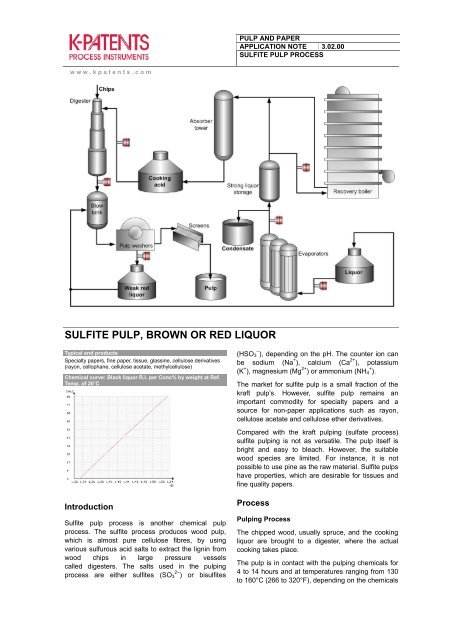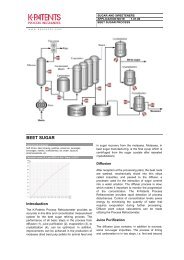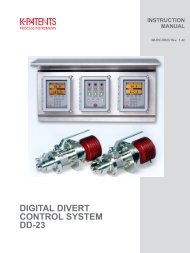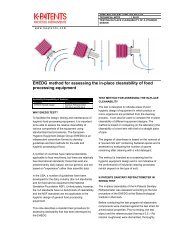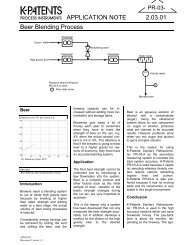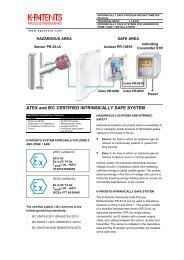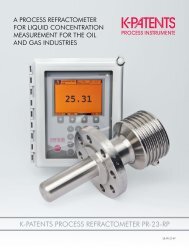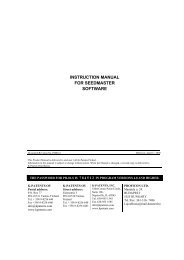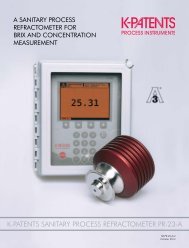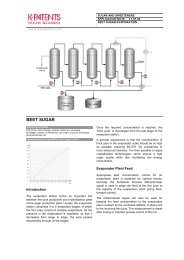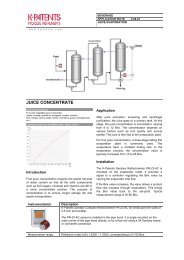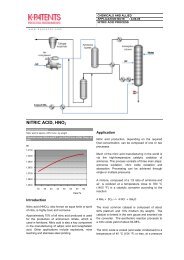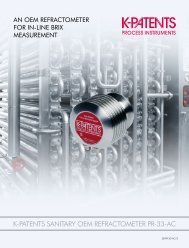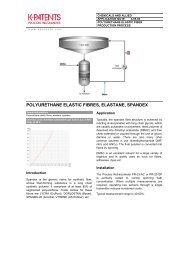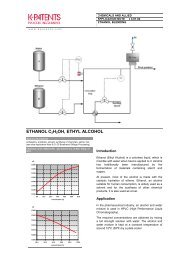3.02.00 Sulphite Pulp Process - K-Patents
3.02.00 Sulphite Pulp Process - K-Patents
3.02.00 Sulphite Pulp Process - K-Patents
Create successful ePaper yourself
Turn your PDF publications into a flip-book with our unique Google optimized e-Paper software.
PULP AND PAPER<br />
APPLICATION NOTE <strong>3.02.00</strong><br />
SULFITE PULP PROCESS<br />
www.kpatents.com<br />
SULFITE PULP, BROWN OR RED LIQUOR<br />
Typical end products<br />
Specialty papers, fine paper, tissue, glassine, cellulose derivatives<br />
(rayon, cellophane, cellulose acetate, methylcellulose)<br />
Chemical curve: Black liquor R.I. per Conc% by weight at Ref.<br />
Temp. of 20˚C<br />
Introduction<br />
Sulfite pulp process is another chemical pulp<br />
process. The sulfite process produces wood pulp,<br />
which is almost pure cellulose fibres, by using<br />
various sulfurous acid salts to extract the lignin from<br />
wood chips in large pressure vessels<br />
called digesters. The salts used in the pulping<br />
process are either sulfites (SO 3 2− ) or bisulfites<br />
(HSO 3 − ), depending on the pH. The counter ion can<br />
be sodium (Na + ), calcium (Ca 2+ ), potassium<br />
(K + ), magnesium (Mg 2+ ) or ammonium (NH 4 + ).<br />
The market for sulfite pulp is a small fraction of the<br />
kraft pulp’s. However, sulfite pulp remains an<br />
important commodity for specialty papers and a<br />
source for non-paper applications such as rayon,<br />
cellulose acetate and cellulose ether derivatives.<br />
Compared with the kraft pulping (sulfate process)<br />
sulfite pulping is not as versatile. The pulp itself is<br />
bright and easy to bleach. However, the suitable<br />
wood species are limited. For instance, it is not<br />
possible to use pine as the raw material. Sulfite pulps<br />
have properties, which are desirable for tissues and<br />
fine quality papers.<br />
<strong>Process</strong><br />
<strong>Pulp</strong>ing <strong>Process</strong><br />
The chipped wood, usually spruce, and the cooking<br />
liquor are brought to a digester, where the actual<br />
cooking takes place.<br />
The pulp is in contact with the pulping chemicals for<br />
4 to 14 hours and at temperatures ranging from 130<br />
to 160°C (266 to 320°F), depending on the chemicals
PULP AND PAPER<br />
APPLICATION NOTE <strong>3.02.00</strong><br />
SULFITE PULP PROCESS<br />
www.kpatents.com<br />
used. <strong>Pulp</strong> and spent cooking liquor are led through<br />
a blow tank to pulp washers. In the washing process,<br />
the spent cooking liquor and the pulp are separated<br />
with hot, pressurized water. The pulp is passed<br />
through screens and into storage. It is ready for<br />
bleaching.<br />
Chemical Recovery<br />
The spent cooking liquor from sulfite pulping is<br />
called brown or red liquor (compared to black liquor<br />
in the kraft process).<br />
After the washers, the weak red liquor enters a<br />
storage tank, having approximately 13-15% solids.<br />
The liquor is concentrated in a multiple-effect<br />
evaporator system and transferred into a strong<br />
liquor tank, when the required concentration reaches<br />
(between 60-65%) the boiler operation. In the<br />
recovery boiler, the strong red liquor is burned off<br />
and the base (usually magnesium) is recovered for<br />
recycling.<br />
The refractometers situated before and after the<br />
digester control the concentration of the cooking<br />
liquor to give optimal digestion of pulp. Measurement<br />
range is 0-15%b.w. and temperature is<br />
approximately 100°C (212°F).<br />
Weak red liquor concentration is measured after the<br />
washers. The temperature is 60°C (140°F) and the<br />
concentration is 20%b.w.<br />
Installations before and after the evaporators<br />
measure concentrations of 10-20%b.w. and 50-<br />
70%b.w. respectively. The temperature is between<br />
120 and 130°C (248 and 266°F). These<br />
concentration measurements are used to maintain a<br />
consistent flow to the feed, maximizing evaporator<br />
capacity. Through the strong liquor measurements,<br />
the refractometer provides a safety control. The<br />
concentration is 60-65%b.w. and the temperature<br />
can rise up to 110°C (230°F).<br />
Installation<br />
The K-<strong>Patents</strong> SAFE-DRIVE <strong>Process</strong><br />
Refractometer PR-23-SD is used to measure<br />
concentrations at different phases of the process.<br />
Instrumentation<br />
Description<br />
K-<strong>Patents</strong> SAFE-DRIVE <strong>Process</strong> Refractometer PR-23-SD for measuring<br />
brown/red liquor dry solids in sulfite pulping process. K-<strong>Patents</strong> SAFE-<br />
DRIVE design allows for safe and easy insertion and retraction of the<br />
sensor under full operating pressure without having to shut down the<br />
process.<br />
Measurement range:<br />
Refractive Index (nD) 1.3200 – 1.5300, corresponding to 0-100 % by weight.


